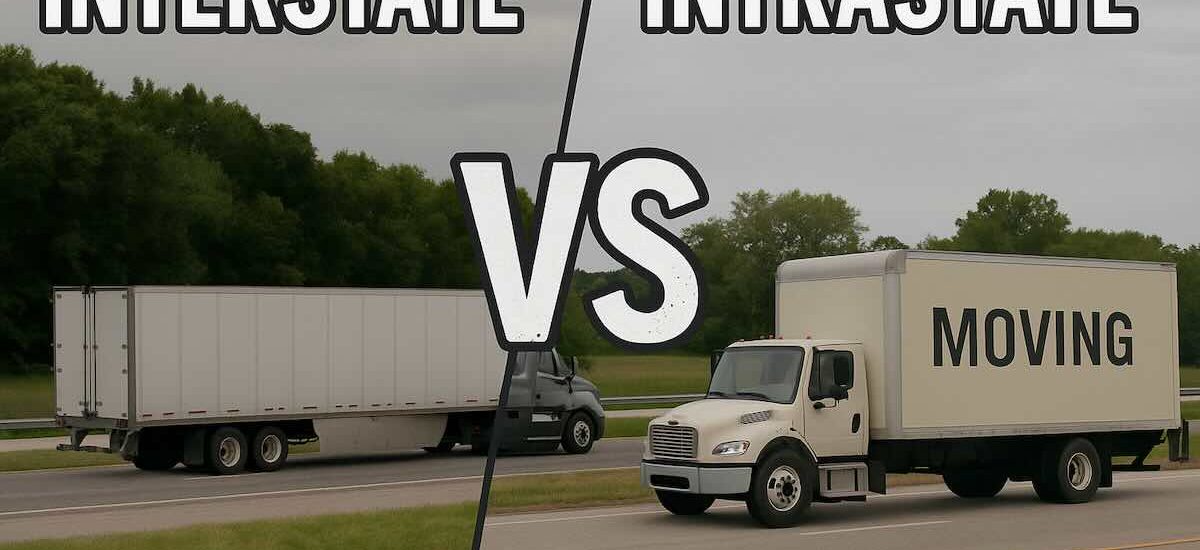Interstate vs Intrastate sound similar, yet regulators treat them differently. Understanding which one applies to your move helps you verify licensing, pick the right valuation coverage, and set realistic timelines. The short version: intrastate = within one state; interstate = across state lines or otherwise part of interstate commerce. A few edge cases; like routing through another state or warehousing en route, mean a move can be “interstate” even if your driver never crosses a border.
Key Points
- Intrastate moves happen entirely within one state and follow that state’s moving rules and permits. (Example: Los Angeles to San Diego.)
- Interstate moves are governed by federal rules when the shipment crosses a state line, passes through another state, or is part of a multi-state route based on the shipper’s intent—even if the truck stays inside one state’s roads.
- Interstate movers need federal authority (USDOT and MC numbers). Intrastate movers typically need a state permit/registration and state-specific insurance filings.
- Valuation choices (e.g., Full Value Protection vs. Released Value at $0.60/lb) exist on interstate moves and may also appear intrastate, but terms vary by state and provider.
Definitions
Interstate move (federally regulated)
- Transportation of household goods between a state and a place outside that state, or between two places in the same state when the route passes through another state, or when the overall shipment is part of interstate commerce based on the shipper’s fixed intent at the time of shipment.
- These moves fall under Federal Motor Carrier Safety Administration (FMCSA) rules, including consumer rights disclosures and valuation options.
Intrastate move (state-regulated)
- Transportation conducted entirely within the boundaries of a single state. The state’s agency (not FMCSA) typically issues permits and sets requirements.
- Example (California): movers performing intrastate household goods moves must hold a state permit and carry required liability and cargo insurance.
Which Rules Apply to Your Move?
Intent and routing decide the category. If your shipment begins in one state and its journey directly or through warehousing continues to another, federal (interstate) rules apply. If every leg begins and ends inside a single state and never passes through another state, state (intrastate) rules apply.
| Move Type | What It Covers | Paperwork to Expect |
|---|---|---|
| Interstate | Crosses a state line; passes through another state; or is part of a multi-state shipment by intent. | USDOT and MC numbers on the mover’s documents; FMCSA booklets (“Your Rights and Responsibilities When You Move”), estimate, order for service, bill of lading, and valuation election. |
| Intrastate | Starts and finishes within a single state without entering another state. | State permit/registration and insurance filings (agency varies by state; e.g., CA BHGS/CPUC). State-specific estimate and liability terms. |
Licensing, Authority, and Insurance; What to Look For
- Interstate movers generally need a USDOT number and operating authority (MC number) to transport household goods for hire.
- Intrastate movers usually carry a state-issued permit and meet state insurance minimums; the issuing office differs by state. (In California, BHGS/CPUC regulates household movers.)
- Valuation options on interstate moves include Full Value Protection and Released Value ($0.60/lb per article). Availability and details for intrastate moves depend on state rules and the provider’s tariff.
Costs and Timelines: What Typically Changes
Interstate pricing is often sensitive to shipment weight/volume, distance, and delivery window. Intrastate pricing still considers access and services, yet the shorter geography can reduce transit time and window size. Ranges fluctuate by season, market, and provider.
| Line Item | When It Appears | How to Influence It |
|---|---|---|
| Delivery window | Interstate: often 3 – 10 days; Intrastate: often same day or next day depending on distance. | Being flexible can reduce price; a tight, guaranteed window usually costs more. |
| Valuation coverage | Chosen at booking; affects interstate paperwork and sometimes intrastate tariffs. | Ask for Full Value Protection pricing up front; know that Released Value is minimal at $0.60/lb per article. |
| Permits / COI | City parking permits and building insurance certificates are common in both move types. | Checking requirements two weeks ahead tends to prevent day-of delays (agency varies by city/state). (State example for CA permitting shown above.) |
Common Mix-ups and Calmer Alternatives
- “It’s intrastate because the truck stays in-state.” The overall shipment can still be interstate based on routing or intent (e.g., goods pass through another state or are staged in-state on the way to another state). A quick FMCSA check avoids surprises.
- Skipping licensing verification. Interstate movers should show USDOT/MC numbers; intrastate movers should show a valid state permit.
- Assuming insurance = valuation. Carrier liability (valuation) is not the same as third-party insurance. Knowing the difference especially the $0.60/lb default; helps you choose coverage that matches your risk tolerance.
FAQ
Does the truck have to cross a state line for my move to be “interstate”?
Not always. If your shipment passes through another state or is part of a multi-state routing by intent, it can be an interstate move under FMCSA even when the vehicle’s visible route stays in-state.
Who regulates intrastate movers?
It depends on the state. Each state designates an agency and sets permit/insurance requirements (for example, California’s BHGS/CPUC).
What documents should I receive for an interstate move?
Expect an estimate, an order for service, a bill of lading, valuation disclosures, and the FMCSA consumer booklet “Your Rights and Responsibilities When You Move.”
What is Full Value Protection vs. Released Value?
Full Value Protection makes the mover responsible up to the replacement value of your shipment (often with deductible choices). Released Value provides minimal coverage at $0.60 per pound per article.
Is pricing very different between interstate and intrastate?
Both consider weight/volume, access, and services. Interstate pricing also reflects longer distances and delivery windows. Intrastate timelines are often shorter, which can lower some scheduling costs. Ranges vary by market and season.
References
- FMCSA: What Is an Interstate Move?
- FMCSA: Interstate vs. Intrastate Commerce (FAQ)
- FMCSA Guidance: Interstate vs. Intrastate (Intent & Routing)
- FMCSA: Your Rights and Responsibilities When You Move
- FMCSA: Liability & Protection (Full Value vs. Released Value)
- California BHGS: Household Movers (Intrastate Example)
- Caltrans: Intrastate Licensing (BHGS/Insurance)
Definitions and requirements are consistent at the federal level for interstate shipments; intrastate rules vary by state. Where ranges or examples appear, they are planning estimates.










